Anoles have become one of the popular lizard choices for first-time reptile owners. There is a wide variety to choose from, most are easy to care for and inexpensive.
Are you thinking of welcoming an anole into your home? Continue reading for more information on the best pet anole lizards you can choose from.
Further Reading:
1. Green Anole
The green anole (Anolis Carolinensis) is probably the most common anole pets.
Males grow to around 8 inches long in captivity, while females are slightly smaller and they can live up to 8 years, so bear their lifespan in mind when committing to an anole pet.
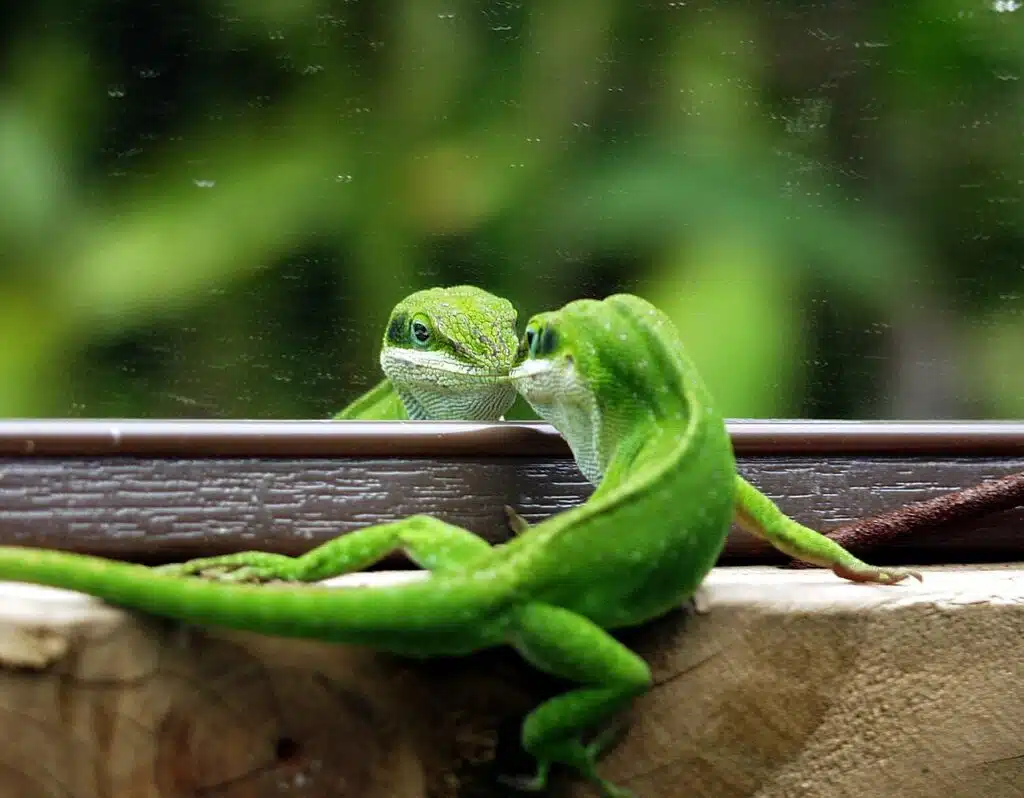
These are small, easy to care for and inexpensive reptiles that prefer no or very limited handling.
Their dietary and housing requirements are easy to meet with some specialized equipment to ensure that they remain happy and healthy in captivity.
While they are easy to care for, this doesn’t mean they are low maintenance and will have regular cleaning and feeding requirements.
They are best kept on their own or in a small group with one male and a few females, as the males as very territorial.
The green anole has the ability to change their color, but not as fast as a chameleon. They change from bright green to brown. Males have a red or pink dewlap.
They are very shy and with very gentle and consistent handling they can grow slightly tame, but they are active and difficult to catch.
They are best when not handled or handling is kept to a minimum. Ensure handling is always done gently.
You can keep a single anole pet in a 10 gallon enclosure, but this is the bare minimum, the larger the better. You will want a larger enclosure if you want to keep a group of three or more green anoles.
They are daytime lizards and will need a tight-fitting screen. You will want to provide a place for them to bask in the sun on branches and twigs.
They are excellent climbers and can climb glass, so ensure your mesh screen lid is tightly locked to avoid escape.
These lizards need 70% humidity, which can be achieved by adding a water bowl to the enclosure along with regular misting. Use a hygrometer to measure humidity levels accurately.
Temperatures should range between 75ºF and 82ºF for twelve hours daily. Night temperatures must not drop below 65ºF.
Related – Best cage for green anole lizards.
2. Brown Anole
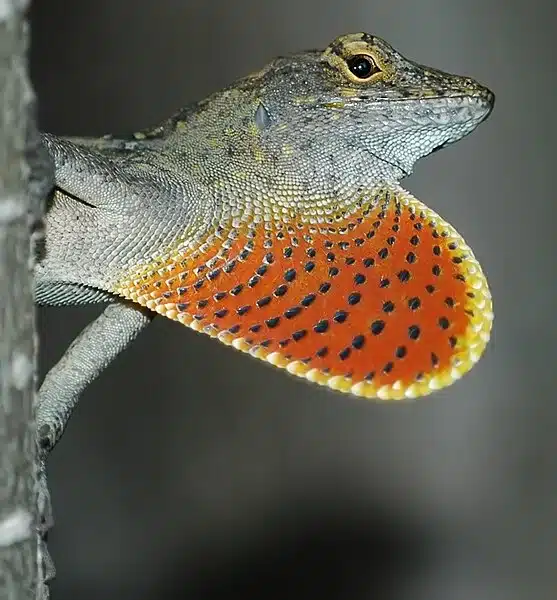
The brown anole (Anolis sagrei) comes from Cuba and has since been introduced to the Bahamas and Florida. They are fun and exciting to own with basic care, making them ideal for the beginner reptile owner.
Brown anoles are not very colorful and tend to be gray or brown in color with males growing up to 8 inches and females up to around 5 inches in length (including their tails).
They have a 3 year life expectancy when living in captivity.
The brown anole does not enjoy being handled and should only be touched when absolutely necessary, such as enclosure cleaning or to prevent escape. Handing can result in unnecessary stress for the anole pet.
They enjoy their humidity to range between 60% and 70%. Add a large water dish and regular misting to keep humidity levels at optimum. Don’t forget to use a digital hygrometer for quick and easy monitoring.
The brown anole enjoys temperatures of between 75ºF and 88ºF during the day with 100ºF for their basking area and 60ºF at night.
Ensure you place ample branches and plants to provide ample hiding and climbing space for your anole pet.
They require UVB lighting which should be provided around 12 hours daily to reduce the risk of metabolic bone disease.
3. Knight Anole
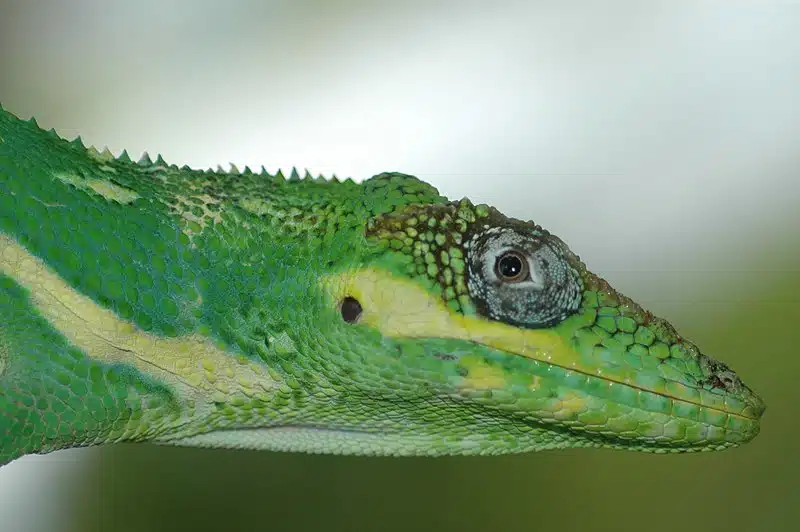
The knight anole (Anolis equestris) grows up to 18 inches in length and comes from Cuba, though they can be found in southern Florida.
They are tree-living lizards that require plenty of shade and branches. These require intermediate level care and can live up to 12 years in captivity.
These anoles do not do well in captivity if caught at adult size, so ensure you find the smallest knight anole when purchasing to ensure that they can acclimate with ease.
The knight anole will require a large enclosure of a minimum of three feet in height with some strong branches that run from the ground to the top of the cage, along with horizontal branches.
They feed on insects, sweet bruits, and baby mice.
They need a well-ventilated enclosure, ensure the screen lid is well secured and locked to reduce the risk of escape. They need plenty of room and are best kept on their own.
If you do house two together the chances of them fighting is high.
Daytime temperatures should range between 80ºF and 86ºF on the warm side and slightly cooler on the other, allowing the anole to regulate its body temperature.
They can overheat in minutes, so ensure you monitor your temperatures using a digital thermometer for accurate and easy monitoring.
Ensure to use a good quality UVB bulb to help the reptile have strong bones and reduce the risk of developing metabolic bone disease.
The knight anole does not enjoy being handled and it will cause stress. Ensure you keep handling to a minimum, only handling for emergencies such as escape and enclosure cleaning.
4. Water Anole
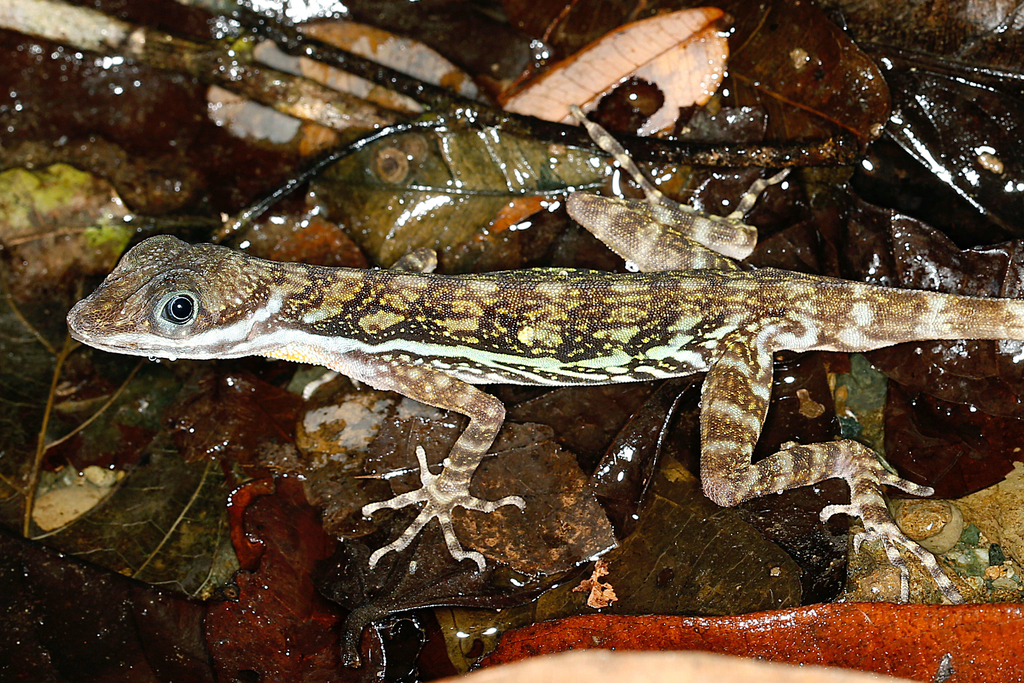
The water anole (Anolis Aquaticus) is a unique anole that comes from Central America and Costa Rica.
They have adapted to spend long periods under water, which can be up to 15 minutes by forming air bubbles which recycle the air supply when under the surface.
They dive under the water, which also acts as an anti-predator technique. As they are not fast lizards, diving under water helps to vanish from predators for a few minutes.
Remember that these anoles come from a tropical climate, which means high humidity levels, which can be easily achieved with the large water dish you will be provided.
Provide ample light and a large enclosure for your water anole to move around with confidence.
5. Jamaican Giant Anole
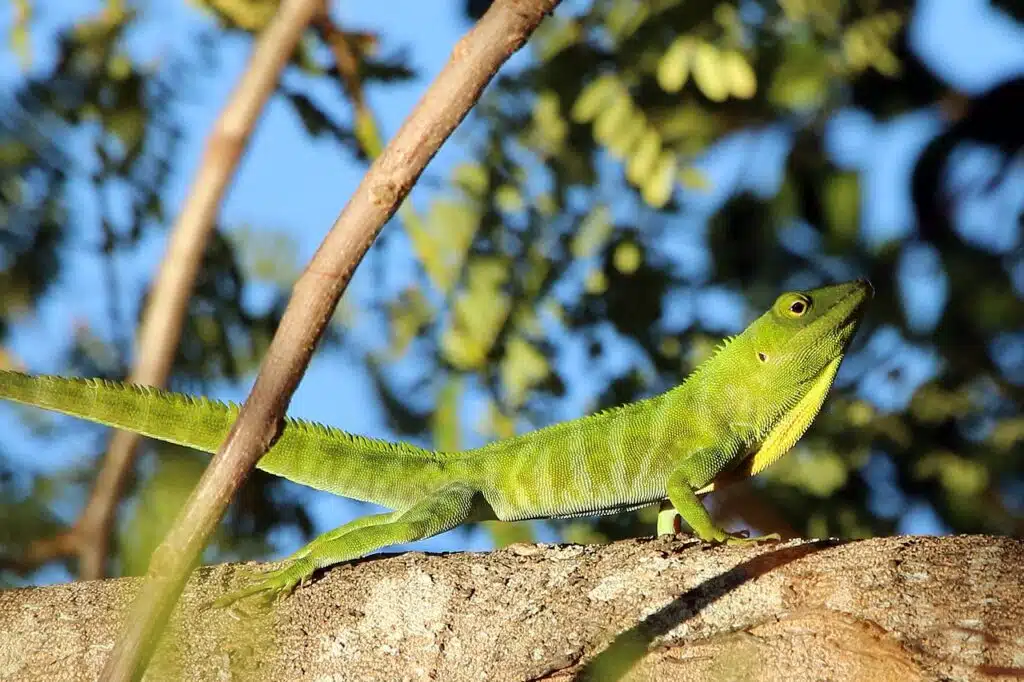
The Jamaican giant anole (Anolis Garmani) can be found in Jamaica, Florida, and the Grand Cayman and is the largest anole from Jamaica.
It is emerald green in color with a green to white underbelly. They can show a black to green coloration which is usually resulting from fear or stress.
The male tends to be significantly larger than the female growing up to an average of 25 centimeters in length from nose to tip of the tail. The largest recorded was 30.5cm in length. Females tend to grow to about 16 centimeters.
These anoles have a pale lateral stripe that is more noticeable in males than females. Males also have a green dewlap with an orange center, which is very noticeable.
6. Bearded Anole
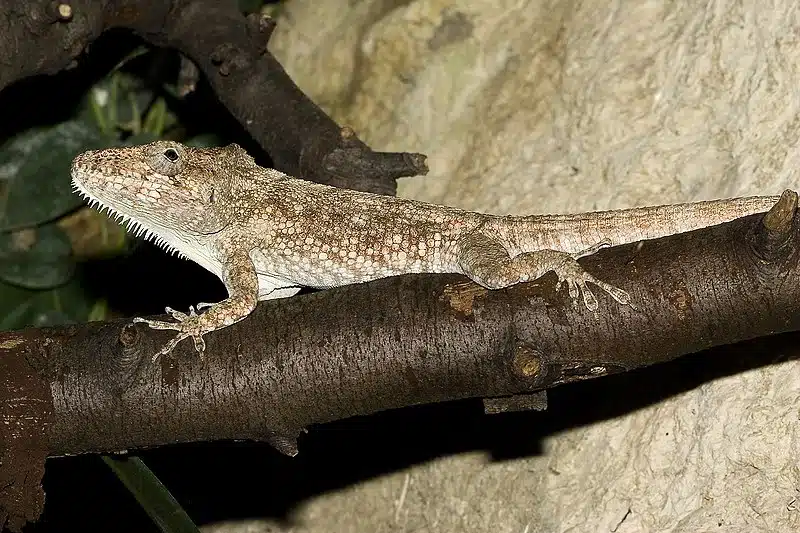
The bearded anole (Anolis Pogus) is an intermediate to expert level reptile pet and with the right care, they can live up to ten years in captivity.
The bearded anole comes from the Caribbean Island of Saint Martin and in the Lesser Antilles where the males grow up to 6 centimeters from snout to vent.
The males are light brown to orange brown with an off-white belly. They have turquoise around their eyes, which sometimes extends up the head.
Females are less colorful but have a mid-dorsal stripe and a white flank stripe.
The western bearded anole (Anolis Barbatus) comes from Western Cuba with adults growing up to 15 centimeters from snout to vent.
They tend to be a gray brown in color with long limbs to help them navigate large trees. They also have a third eye, the same as an iguana, which defects fluctuations in light, playing a role in escaping from predators.
They are able to camouflage to protect themselves against predators, such as birds.
7. Monkey Anole
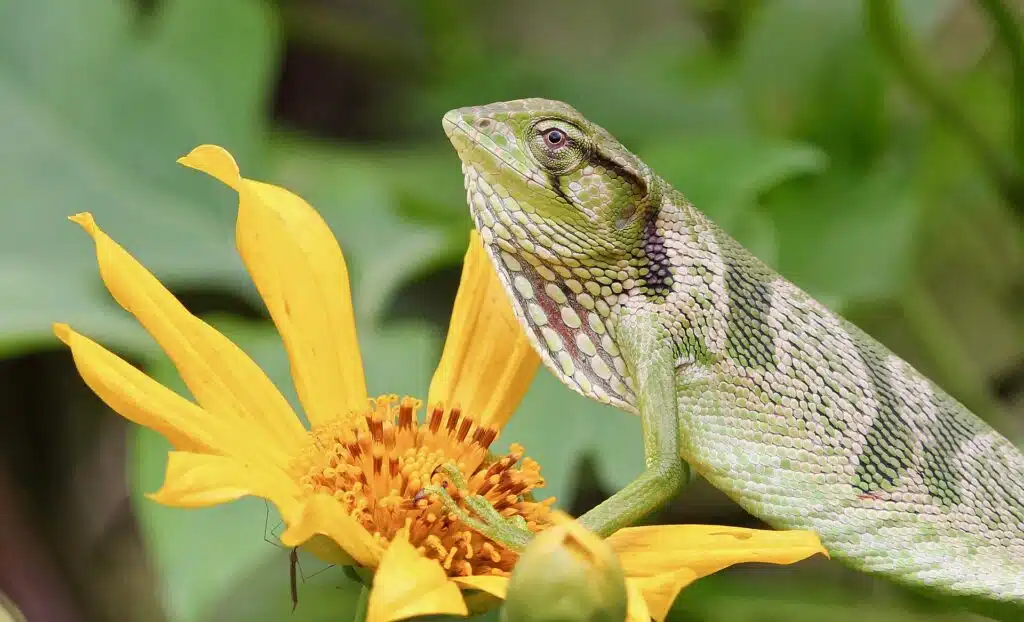
The monkey anole (Polychrus gutturosus) comes from South and Central America. These tropical reptiles live in the jungles and forests of Ecuador and can grow up to an impressive 70 centimeters in length, including their long tail.
Males are smaller than females.
They are colorful lizards and affordable to purchase. They are fast and make great pets, ideal for the beginner or expert reptile owner.
The males have a blue or purple dewlap. While females also have the dewlap, it is not as bright.
Their tails are double the length of the body, ending in a fine tip. They can be a host of colors from blue, green, and white with black spots.
They can live up to 5 years or more with the right care.
It is best to keep these anole pet lizards to watch and enjoy their antics, rather than looking for a reptile you can handle. They are fast and will escape when given the chance.
A 20 gallon enclosure is the minimum for adults. Juvenile can be kept in a 10 gallon, but will need to upgrade as they grow. Never house two males together, they will fight.
These are excellent climbers, so ensure that the screen lid on the tank is secured to reduce the risk of escape. Provide plenty of hiding places so your anole can feel safe and secure.
Daytime temperatures should be around 75ºF with the basking area being 80ºF. Night temperature can drop 10ºF – 15ºF. Light should be provided for 12 hours to create a day and night cycle.
They will need UVB lighting to improve the metabolism of vitamin D3 and converting into calcium to reduce the risk of metabolic bone disease.
They appreciate a high humidity of between 60% and 70%, which can be monitored with a digital hygrometer to ensure accurate and easy monitoring.
8. Crested Anole
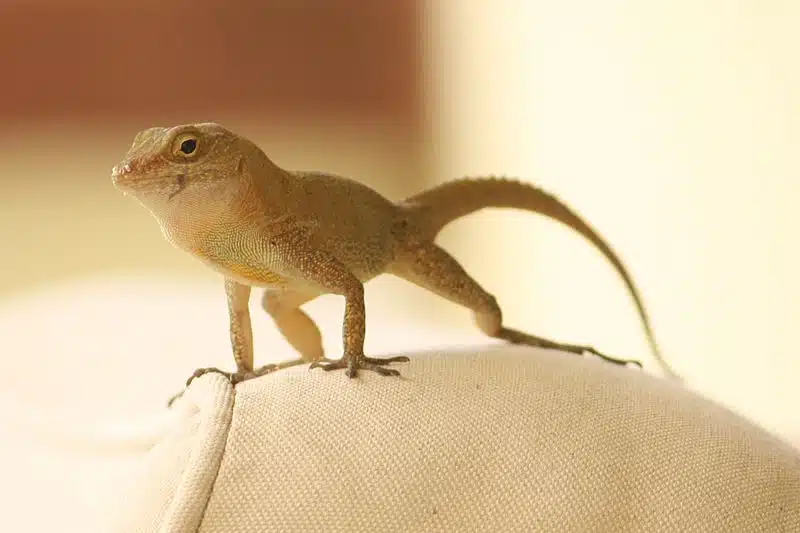
The crested anole (Anolis cristatellus) is a small anole with males being easily recognizable with a fin (crest) that runs down the tail.
Females also have a crest, though it is much smaller than the males.
These anoles grow up to 3 inches (7.5cm) for males and 2.9 inches (7.3cm) for females.
Males are much prettier than females with juveniles being colored differently to the adults.
Males can be recognized with their permanent crest. They have a variable color with the head and body being a green-gray to bronze with brown spots and a yellow to green belly and white throat.
Dewlaps range from green-yellow to mustard with red-orange or burnt orange along with the martin.
Juveniles are brown with purple-brown spots on the throat, they often have a mid-dorsal stripe. Some females retain the stripe into adulthood.
These anoles are also able to change their colors based on their behavioral state.
The crested anole only needs a 10 gallon enclosure, due to its small size. If you wish to add another crested anole pet, add an extra 5 gallons of enclosure per anole you introduce.
Bear in mind you cannot house 2 males in the same enclosure as they will fight.
Ensure you have a tight-fitting mesh screen lid. Focus on height as these anoles don’t spend too much time on the ground.